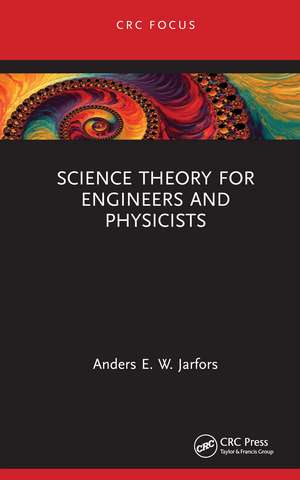Science Theory for Engineers and Physicists
Autor Anders E. W. Jarforsen Limba Engleză Hardback – 31 dec 2024
Science Theory for Engineers and Physicists provides a basic understanding of “the method” as a question and to understand how a reliable answer that can be validated is constructed. It covers the basic terminology and methods which are exemplified for ease of understanding for the reader. Testing of hypotheses and quantitative understanding of uncertainty and uncertainty propagation are also illustrated.
The book is intended to be used with experimental work as a final or thesis project for undergraduate or graduate students who have not had prior experience in science theory or data handling and uncertainty.
Preț: 384.68 lei
Nou
Puncte Express: 577
Preț estimativ în valută:
73.61€ • 80.21$ • 62.03£
73.61€ • 80.21$ • 62.03£
Carte disponibilă
Livrare economică 02-16 aprilie
Livrare express 18-22 martie pentru 24.100 lei
Preluare comenzi: 021 569.72.76
Specificații
ISBN-13: 9781032846712
ISBN-10: 1032846712
Pagini: 88
Ilustrații: 16
Dimensiuni: 138 x 216 x 11 mm
Greutate: 0.25 kg
Ediția:1
Editura: CRC Press
Colecția CRC Press
Locul publicării:Boca Raton, United States
ISBN-10: 1032846712
Pagini: 88
Ilustrații: 16
Dimensiuni: 138 x 216 x 11 mm
Greutate: 0.25 kg
Ediția:1
Editura: CRC Press
Colecția CRC Press
Locul publicării:Boca Raton, United States
Public țintă
Postgraduate and Undergraduate AdvancedCuprins
1 Introduction
1.1 The role of science and a scientist
1.2 The difference between different sciences
1.3 Political bias in science
1.4 The purpose of this book
2 Laws
2.1 Empirical science
2.2 À priori science
3 Definitions
3.1 Stipulating definitions
3.2 Operational definitions
4 Hypotheses
4.1 Hypotheses and requirements on them
4.2 Explanations
4.3 Modelling
4.4 Test of a hypothesis
5 Science and the boundaries of science
6 Treatment of measured data
6.1 Accuracy, precision and error
6.2 Uncertainty estimation
6.3 Error in measurements and significant digits
6.4 Uncertainty propagation
6.5 How do we know that there is a significant difference between measurements
7 Bibliography
8 Appendix
8.1 The Chi-square test (Pearson's variant)
8.2 The Chi-square table
8.3 Analysis of variance (ANOVA)
8.4 The F-test table
1.1 The role of science and a scientist
1.2 The difference between different sciences
1.3 Political bias in science
1.4 The purpose of this book
2 Laws
2.1 Empirical science
2.2 À priori science
3 Definitions
3.1 Stipulating definitions
3.2 Operational definitions
4 Hypotheses
4.1 Hypotheses and requirements on them
4.2 Explanations
4.3 Modelling
4.4 Test of a hypothesis
5 Science and the boundaries of science
6 Treatment of measured data
6.1 Accuracy, precision and error
6.2 Uncertainty estimation
6.3 Error in measurements and significant digits
6.4 Uncertainty propagation
6.5 How do we know that there is a significant difference between measurements
7 Bibliography
8 Appendix
8.1 The Chi-square test (Pearson's variant)
8.2 The Chi-square table
8.3 Analysis of variance (ANOVA)
8.4 The F-test table
Notă biografică
Anders E. W. Jarfors is a Swedish researcher in materials and manufacturing. He did his MSc and PhD at the Royal Institute of Technology in Sweden. He has worked at the Royal Institute of Technology in Stockholm and the Swedish Institute of Metals Research (formerly KIMAB and now RISE and Swerim). He has also worked at the Singapore Institute of Manufacturing Technology and MMI Holding Pte Ltd in Singapore. He was also an Adjunct Associate professor at Nanyang Technological University. He has held guest and visiting professorships in China with the China Academy of Machinery Sciences and Technology and at Nanyang Technological University, Singapore. He is currently a professor of materials and manufacturing at Jönköping University and a visiting professor at Cranfield University and Sustainable Manufacturing.
He has a long list of empirical work in materials science and manufacturing processes ranging from metal casting and sheet metal forming to powder metallurgy and spray forming. The main research is on metal casting and automotive components. He is also an active teacher, and there is a need for a simplistic description of the foundations of a scientific approach. This is commonly seen in the approach and at the start of final year projects where there are gaps in approach and the ability to understand what is proven and what is suspected.
He has a long list of empirical work in materials science and manufacturing processes ranging from metal casting and sheet metal forming to powder metallurgy and spray forming. The main research is on metal casting and automotive components. He is also an active teacher, and there is a need for a simplistic description of the foundations of a scientific approach. This is commonly seen in the approach and at the start of final year projects where there are gaps in approach and the ability to understand what is proven and what is suspected.
Descriere
This book is a short hands-on guide to the theory of science to provide students in engineering fields and physicists with a tool for a systematic approach to inquiry.
